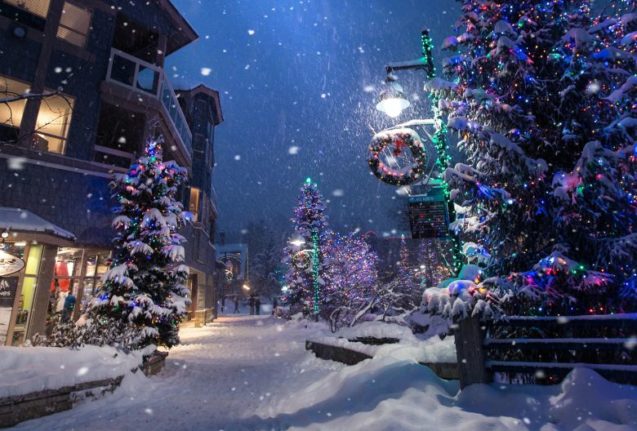If you’re a diehard Christmas fan, in love with all the winter-time traditions and holiday festivities, you’ll fit right in with most Norwegians.
According to a new survey, a whopping 93 percent of Norwegians plan to decorate their homes for Christmas, and the vast majority also plan to put up a Christmas tree.
So, it should come as no surprise that a country of dedicated Christmas aficionados also dedicates a lot of time and attention to other winter-time traditions.
In this article, we’ll cover the most important December ones – from widely loved favourites such as Christmas and New Year’s Eve celebrations to St. Lucia’s Day, Small Christmas Eve, the Romjul period – and much more!
An early start to the holiday season
First things first – Norwegians like to start their holiday season early.
Expect to see people starting with Christmas shopping and baking beloved sweet staples already in the first week of December.
You’ll be able to find Christmas events – such as concerts and plays – throughout the month. At the same time, Norwegian restaurants will start serving traditional Christmas food, while shops will start selling seasonal cookies (gingerbread cookies are especially popular) and drinks (such as special Christmas beers, juleøl, and sodas, julebrus).
If you’re looking to try festive Christmas dishes, try finding some lamb ribs (called pinnekjøtt in Norwegian) if you’re located in Eastern Norway, or pork belly (ribbe in Norwegian) in you find yourself in Western or Northern Norway.
Christmas markets and fairs
Many Norwegian cities have dedicated Christmas shops, markets, and fairs that open as early as mid-November. While many of these markets open in November, most stay open throughout December.
From the Jul i Vinterland Christmas market in Oslo to Bergen’s Christmas market on Festplassen square and Stavanger’s Julebyen Egersund, you can find our overview of Norway’s top Christmas markets and fairs here.
Expect to find the streets in most Norwegian towns – as well as homes – decorated with shining lights and festive decorations.
St. Lucia’s Day (December 13th)
In Norway, as well as in other Nordic countries, St. Lucia’s Day is celebrated on December 13th.
On the day, parades take place in which children – wearing white cotton outfits – carry lights and sing the Santa Lucia song.
It is a Christian tradition that commemorates Saint Lucy, a legendary martyr who brought food and helped persecuted Christians hiding in the Roman catacombs in the 4th century.
One girl in the ceremonial parade is usually chosen to portray Saint Lucy.
Moreover, the day is widely celebrated as a festival of light; for Christians, it ushers the Christmas season.
The day is mostly celebrated in kindergartens and lower elementary schools in Norway. In contrast, in Sweden, it is an event that mainly involves teenagers.
“Little Christmas Eve”, 23 December
On December 23rd, Norwegians traditionally celebrate “‘Little Christmas Eve.” The custom involves putting up and decorating Christmas trees, eating special treats, and watching Christmas movies or shows.
However, the tradition is slowly going out of fashion, and more and more Norwegians have started putting up their trees on other (often earlier) dates.
The tradition of bringing trees into the home the day before Christmas Eve was originally imported from Germany in the 19th century. However, younger generations of Norwegians nowadays tend to put up trees earlier.
Christmas Eve – Julaften (December 24th)
Norway is a bit peculiar in the sense that the main Christmas festive day is December 24th, Christmas Eve.
On the said days, families gather to spend time together, open presents, and enjoy a big and hearty (traditional) meal – most often dinner.
Some Norwegian families also head to church to hear a Christmas service in the morning.
Christmas Eve is usually reserved for families, and Norwegians tend to stay at home (or visit relatives) throughout the day.
The following day, December 25th, is often spent recovering from the food coma resulting from all the food consumed on Christmas Eve.
Romjul (December 27th – December 30th)
After that, the next big tradition starts on the third day of Christmas (December 27th) and runs until New Year’s Day.
It’s called Romjul, and it refers to the week between Christmas and New Year’s.
- READ MORE: Here’s what you need to know about Romjul
During this time, Norwegians usually socialize, relax, take time off, and spend time with their families and friends.
Binge-watching series and movies, socializing over hot drinks and brunches, family dinners, and skiing trips are commonly enjoyed activities during this time. The key focus? Recharging your internal batteries.
New Year’s Eve (December 31th)
On New Year’s Eve, Norwegians tend to meet family or friends for dinner (the more well-off might even enjoy dinner at a cabin). The mood is very festive, and Norwegians tend to approach New Year with a lot of optimism.
Also, expect Norwegians to dress up for New Year’s Eve. In bigger cities, Norwegians tend to leave their homes and find good locations to enjoy the New Year’s fireworks.
When the clock strikes midnight, they will wish a happy New Year to all those nearby, as well as send out messages to family and friends.
Should you encounter Norwegians on the street at this time, expect an unprecedented level of friendliness – some might even call out to you from a balcony or across the street to wish you a happy New Year!
The following day, January 1st, is a day of recovery and rest – especially if you partied long and hard into the night the day before.
Furthermore, Norway’s King Harald gives a New Year’s speech on the 1st of January, often characterized by hope, optimism, gratitude, and encouragement.



 Please whitelist us to continue reading.
Please whitelist us to continue reading.
Member comments